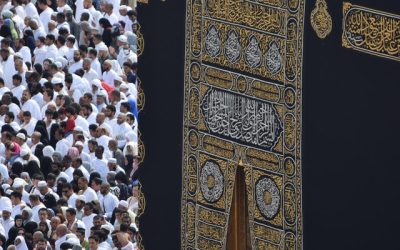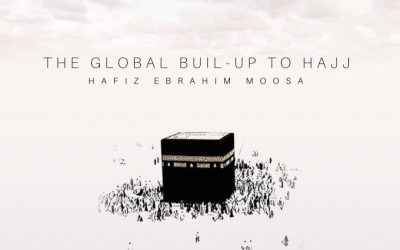Hajj
INTRODUCTION:
Hajj is mentioned in the Hadîth as one of the Pillars of Islâm. It is a duty to be performed by every Muslim who has the necessary wealth.
Hajj is Fardh on every Muslim once in a life time. However, one may perform it more than once.
Hajj is an ibâdah in which money is spent in Allâh’s way and strength is sacrificed for the pleasure of Allâh Ta’âla. At the same time it is a test of patience.
Hajj also provides Muslims from all parts of the world the opportunity of meeting at a central venue to strengthen the bonds of Muslim Brotherhood.
BACKGROUND:
To understand the concept of Hajj, one has to have some background knowledge of the history of Hajj: when it became Fardh; why it became Fardh; how it became Fardh.
Allâh Ta’âla tests man in order to elevate the position of the Believers among them. Many centuries ago, Nabî Ibrahim (AS) was commanded by Allâh Ta’âla to leave his wife, Hâjirah (A.S.) and his infant son, Isma’îl (A.S.) in the desert with little or nothing to eat and drink. Soon the meagre food and drink were finished. In the scorching sun, their thirst grew and the baby, Isma’îl (A.S.) started crying in desperation. Hazrat Hâjirah (A.S.) started running between two hillocks, namely (Safa Marwah) searching for water. After having run between the two hillocks seven times, when she returned to her infant son, she thought a spring had begun to flow at the heels of Isma’îl (A.S.). She was surprised but at the same time delighted. She quickly made a mud heap around the water to prevent it from flowing away, saying Zam Zam meaning to stop. Thus, they were able to quench their thirst whenever they felt thirsty.
This water started taking the shape of a permanent well – a haven for thirsty, travellers. They made this spot their halfway station to quench their thirst and that of their animals. Soon people started settling at the station and thus, Makkah came into existence. The water that sprang up at the heels of Hazrat Isma’îl (A.S.) is known as Zam Zam.
These two hillocks between which Hazrat Hâjirah (A.S.) ran, are called Safâ and Marwah. Allâh Ta’âla loved Hazrat Hâjirah’s (A.S.) sacrifice. Thus, till the day of Qiyâmah, who ever goes for Umrah or Hajj
will be required to run between these two hillocks to experience Hazrat Hâjirah’s (A.S.) desperation.
After some time, when Hazrat Ibrahîm (A.S.) returned, he and Hazrat Isma’îl (A.S.) built the Ka’bah on the very foundation of the Ka’bah which was built by Hazrat Âdam (A.S.).
Later, Hazrat Ibrahîm (A.S.) was tested for the second time when Allâh Ta’âla commanded him to sacrifice his beloved son. But before the knivfe could pass through the throat of Hazrat Isma’îl (A.S.), Allâh Ta’âla replaced him with a ram from Jannah. Thus, the ram was sacrificed instead of Hazrat Isma’îl (A.S.). To honour this selfless act of Hazrat Ibrahîm (A.S.) we offer a sacrifice at the time of Eidul-Adhâ.
While Hazrat Ibrahîm (A.S.) was on his way to the place of sacrifice, Shaytân tried to deter him on three separate occasions from slaughtering his son. On all three occasions Hazrat Ibrahîm (A.S.) pelted him with stones. To commemorate this occasion, the Hajee is required to pelt stones at the three pillars which represent the shaytân.
Hajj thus a reminder of the sacrifices the beloved prophets of Allâh (AS) made in their endeavour to obey every command of Allâh Ta’âla – be it by sacrificing their wealth, families or life.
The Qur’ân says:
“For Haj are the months well known. If any one undertakes that duty therein let there be on obscenity, no wickedness nor wrangling in the Hajj, And whatever good you do, be sure Allâh knoweth it”. (Surah Baqarah – 197)
BENEFITS OF HAJJ.
A Hajee is the guest of Allâh Ta’âla.
“Verily there shall be no reward for a righteous pilgrimage except Jannah.”
“Whoever performs Haj for the sake of pleasing Allh and therein utters no word of evil, nor commits any evil deed, shall return from it as free from sins as the day on which his mother gave birth to him.
“A Hajji never becomes poor and destitute.
WARNINGS FOR NOT PERFORMING HAJJ:
“Whoever possesses the provisions (for the journey) and the means of transport to bring him to the house of Allâh yet he does not perform Hajj, then there is no difference in him dying as a Jew or as a Christian. The Book “Virtues of Hajj” by Shaikhul – Hadîth Hazrat Moulana Zakariyya (R.A.) is highly recommended.
CONDITIONS FOR HAJJ TO BECOME FARDH:
One must be a Muslim.
To be mature.
To be sane.
A woman must travel with her husband or a Mahram (i.e. one women she cannot marry at all).
The pilgrim should have sufficient money for his journey as well as for his dependants whom he leaves at home.
Women must be in Iddat.
HAJJ GLOSSARY
Terms, words and names of places which will be used in the lessons on Hajj.
DOOR OF THE KA’BAH: The door of the ka’bah is situated head-high in the wall between the Hajare-Aswad and the Hateem, closer to the Hajare-Aswad.
HAJARE-ASWAD: A black stone positioned at the South Eastern corner of the Ka’bah. According to tradition, the Hajare-Aswad was sent down from Jannah. Originally it was white in colour but with the passing of time it has turned black as a result of the sins of man kind. Tawâf begins at Hajare-Aswad.
HAJJ: The Arabic word “Hajj” means “to intend”. In Shariah, Hajj means to travel to Makkah with the intention of performing certain acts during the prescribed days of Zil-Hajjah as described in the Qur’ân and Ahâdeeth.
HATEEM: The semi-circular area surrounded by a shoulder high wall next to the Ka’bah. The Hateem is part of the Ka’bah.
IHRÂM: The word “Ihrâm” means to “to make Harâm”. Thus, when in the state of Ihrâm which symbolically refers to the wearing of two sheets of unsewn with material, one is not permitted to do certain things, (i.e. these actions become Harâm to the person who is in Ihrâm. When a person goes for Hajj or Umrah he may not enter Makkah without Ihrâm).
KA’BAH: A cube-shaped building initially built by Nabî Adam (AS), then by Hazrat Ibrahîm (AS). It is towards this building that all Muslims face during Salâh.
MAKKAH: A city in Arabia where the great Masjid of Islâm known as “The Haram” or “Masjidul Harâm” is situated.
MASJIDUL-HARÂM: The masjid in the city of
MIQÂT: (P1. Mawâqît) There are five places around Makkah which were demarcated by Rasulullah S.A.W. They are called Mawaqît. One may not pass any of these Mawaqît without Ihrâm. They are:
1. Zhul Hulaifa (i.e. Birali)
2. Juhfah.
3. Yalamlam
4. Qarn
5. Zhâte Iraq.
MIZÂB: The gutter on the roof of the Holy Ka’bah on the side of the Hatîm.
MULTAZAM: The area between the Hajare-Aswad and the door of the Ka’bah is known as the Multazam. This is a place where Duas are as- suredly accepted.
RUKNE-YAMANI: The corner of the Holy Ka’bah facing towards Yaman.
TALBIYAH: To recite “Labbaik” in full.
Courtesy: Jamiat Fordsburg





0 Comments